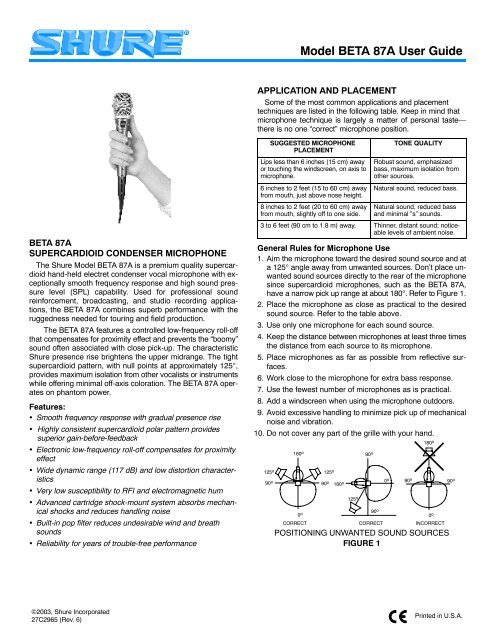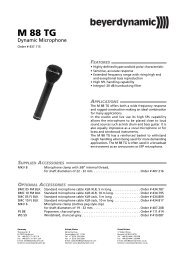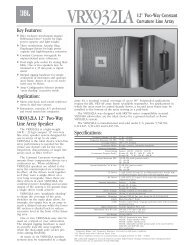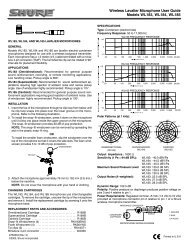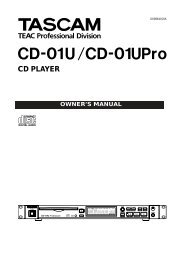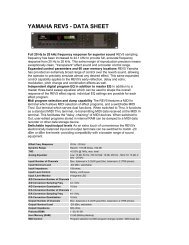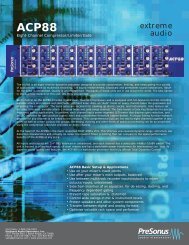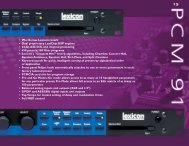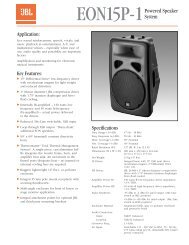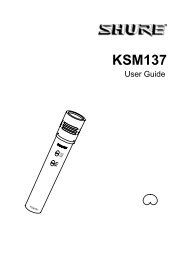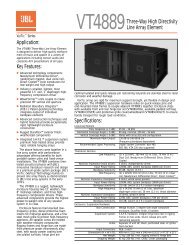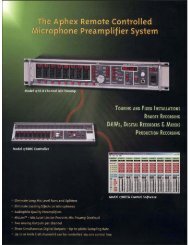Model BETA 87A User Guide
Model BETA 87A User Guide
Model BETA 87A User Guide
Create successful ePaper yourself
Turn your PDF publications into a flip-book with our unique Google optimized e-Paper software.
<strong>Model</strong> <strong>BETA</strong> <strong>87A</strong> <strong>User</strong> <strong>Guide</strong>APPLICATION AND PLACEMENTSome of the most common applications and placementtechniques are listed in the following table. Keep in mind thatmicrophone technique is largely a matter of personal taste—there is no one “correct” microphone position.SUGGESTED MICROPHONEPLACEMENTLips less than 6 inches (15 cm) awayor touching the windscreen, on axis tomicrophone.6 inches to 2 feet (15 to 60 cm) awayfrom mouth, just above nose height.8 inches to 2 feet (20 to 60 cm) awayfrom mouth, slightly off to one side.TONE QUALITYRobust sound, emphasizedbass, maximum isolation fromother sources.Natural sound, reduced bass.Natural sound, reduced bassand minimal ”s” sounds.<strong>BETA</strong> <strong>87A</strong>SUPERCARDIOID CONDENSER MICROPHONEThe Shure <strong>Model</strong> <strong>BETA</strong> <strong>87A</strong> is a premium quality supercardioidhand-held electret condenser vocal microphone with exceptionallysmooth frequency response and high sound pressurelevel (SPL) capability. Used for professional soundreinforcement, broadcasting, and studio recording applications,the <strong>BETA</strong> <strong>87A</strong> combines superb performance with theruggedness needed for touring and field production.The <strong>BETA</strong> <strong>87A</strong> features a controlled low-frequency roll-offthat compensates for proximity effect and prevents the “boomy”sound often associated with close pick-up. The characteristicShure presence rise brightens the upper midrange. The tightsupercardioid pattern, with null points at approximately 125°,provides maximum isolation from other vocalists or instrumentswhile offering minimal off-axis coloration. The <strong>BETA</strong> <strong>87A</strong> operateson phantom power.Features:• Smooth frequency response with gradual presence rise• Highly consistent supercardioid polar pattern providessuperior gain-before-feedback• Electronic low-frequency roll-off compensates for proximityeffect• Wide dynamic range (117 dB) and low distortion characteristics• Very low susceptibility to RFI and electromagnetic hum• Advanced cartridge shock-mount system absorbs mechanicalshocks and reduces handling noise• Built-in pop filter reduces undesirable wind and breathsounds• Reliability for years of trouble-free performance3 to 6 feet (90 cm to 1.8 m) away. Thinner, distant sound; noticeablelevels of ambient noise.General Rules for Microphone Use1. Aim the microphone toward the desired sound source and ata 125° angle away from unwanted sources. Don’t place unwantedsound sources directly to the rear of the microphonesince supercardioid microphones, such as the <strong>BETA</strong> <strong>87A</strong>,have a narrow pick up range at about 180°. Refer to Figure 1.2. Place the microphone as close as practical to the desiredsound source. Refer to the table above.3. Use only one microphone for each sound source.4. Keep the distance between microphones at least three timesthe distance from each source to its microphone.5. Place microphones as far as possible from reflective surfaces.6. Work close to the microphone for extra bass response.7. Use the fewest number of microphones as is practical.8. Add a windscreen when using the microphone outdoors.9. Avoid excessive handling to minimize pick up of mechanicalnoise and vibration.10. Do not cover any part of the grille with your hand.125 o180 o 125 o90 o 0 o 90 oCORRECT125 o 90 o 0 o180 o 90 o 90 oCORRECT180 o90 o0 oINCORRECTPOSITIONING UNWANTED SOUND SOURCESFIGURE 1©2003, Shure Incorporated27C2965 (Rev. 6)Printed in U.S.A.
OPERATIONPowerThe <strong>BETA</strong> <strong>87A</strong> requires phantom power. This may be suppliedto the microphone from an external power supply (such asthe Shure model PS1A) or directly from preamplifiers, mixers,or consoles with built-in phantom power. Suitable sourcesshould provide 11 to 52 Vdc phantom voltage.Proximity EffectUnidirectional microphones such as the <strong>BETA</strong> <strong>87A</strong> progressivelyboost bass frequencies by 10 to 15 dB at 100 Hz whenthe microphone is at a distance of about 6 mm (1/4 in.) from thesound source. This phenomenon, known as proximity effect,creates a warmer, more powerful sound. To prevent explosivelow frequency sound during close-up use, the <strong>BETA</strong> <strong>87A</strong> bassresponse gradually rolls off. This provides greater control andhelps the user take advantage of proximity effect.Wind NoiseThe <strong>BETA</strong> <strong>87A</strong> has an integral wind and pop filter providingexcellent protection against most wind and breath noise. Underadverse conditions, such as high winds or close proximity to a“problem” vocalist, the optional foam windscreen can be used.ImpedanceUse a minimum load impedance of 800 ohms for maximumsignal handling and minimum distortion. The load may be aslow as 150 ohms, but a reduction in output signal strength andoutput clipping level results.SPECIFICATIONSCartridge TypeCondenser (electret bias)Frequency Response50 to 20,000 Hz (see Figure 2)Polar PatternSupercardioid (see Figure 3)Output ImpedanceRated at 150 ohms (100 ohms actual ±20%)Recommended minimum load impedance: 800 ohmsSensitivity (at 1,000 Hz)Open Circuit Voltage . . . . . . . . . . . . . . . . . –52.5 dBV/Pa (2 mV)(1 Pa = 94 dB SPL)Clipping Level (at 1,000 Hz)1000 ohm Load . . . . . . . . . . . . . . . . . . . . . . . . . . –6 dBV (0.5 V)Maximum SPL (at 1,000 Hz)140.5 dB (0.25% THD, 1000 ohm load)Self-Noise (equivalent sound pressure level; measured with truerms voltmeter)23.5 dB typical, A-weighted25.5 dB typical, weighted per DIN 45 405Dynamic Range117 dB (maximum SPL to A-weighted noise level)Signal-to-Noise Ratio70.5 dB at 94 dB SPL (IEC 651)*PolarityPositive pressure on diaphragm produces positive voltage on pin2 relative to pin 3PowerPhantom Supply Requirement . . . . . . . . . 11 to 52 Vdc, positive. . . . . . . . . . . . . . . . . . . . . . . . . . . . . . . . . . . . at both pins 2 and 3Current Drain . . . . . . . . . . . . . . . . . . . . . . . . . . . . . . 1.0 to 1.2 mAConnectorThree–pin (XLR) professional audioCaseAluminum construction with blue metallic finish, and hardenedsteel grille with nickel satin chrome platingDimensionsSee Figure 4Net Weight207 grams (7.6 oz)*S/N ratio is difference between 94 dB SPL and equivalent SPL of self–noise A-weighted.CERTIFICATIONEligible to bear CE Marking. Conforms to European EMC Directive89/336/EEC. Meets applicable tests and performance criteria inEuropean Standard EN55103 (1996) parts 1 and 2, for residential(E1) and light industrial (E2) environments.FURNISHED ACCESSORIESSwivel Adapter . . . . . . . . . . . . . . . . . . . . . . . . . . . . . . . . A25DCarrying/Storage Bag . . . . . . . . . . . . . . . . . . . . . . . . . 26A13OPTIONAL ACCESSORIESPhantom Power Supply . . . . . . . . . . . . . . . . . . . . . . . . PS1AIsolation Mount . . . . . . . . . . . . . . . . . . . . . . . . A55M, A55HMWindscreen . . . . . . . . . . . . . . . . . . . . . . . . . . . . . . . . . A85WSCable (7.6 m—25 ft) . . . . . . . . . . . . . . . . . . . . . . . . . . . C25FREPLACEMENT PARTSGrille . . . . . . . . . . . . . . . . . . . . . . . . . . . . . . . . . . . . . . . RK312Cartridge . . . . . . . . . . . . . . . . . . . . . . . . . . . . . . . . . . . . . R193Replacement Amplifier Assembly . . . . . . . . . . . . 90KF26002
<strong>BETA</strong> <strong>87A</strong>MICROPHONE ÉLECTROSTATIQUE À CONFIGU-RATION SUPERCARDIOÏDELe modèle Shure <strong>BETA</strong> <strong>87A</strong> est un microphone à main dequalité supérieure pour captage vocal à condensateur à électretet à configuration supercardioïde; il offre une réponse enfréquence exceptionnellement uniforme et un niveau de pressionacoustique (NPA) élevé. Utilisé pour la sonorisation professionnelle,la radiodiffusion et les enregistrements en studio,le <strong>BETA</strong> <strong>87A</strong> est à la fois extrêmement performant et suffisammentrobuste pour les tours de chant et la prise de son en extérieur.Le <strong>BETA</strong> <strong>87A</strong> comprend une atténuation de basse réglablequi compense l’effet de proximité et évite le son «caverneux»souvent associé au captage de près. La courbe de présencecaractéristique de Shure ajoute de la brillance dans la gammemédiane. La configuration supercardioïde compacte à positionsde captage minimal à environ 125° offre une isolationmaximale des autres chanteurs ou instruments tout en créantune coloration hors axe minimale. Le <strong>BETA</strong> <strong>87A</strong> fonctionne suralimentation en duplex.Avantages :• Réponse en fréquence uniforme avec courbe de présencegraduelle• La courbe de directivité supercardioïde hautementconstante donne un gain avant Larsen supérieur• L’atténuation de basse électronique compense l’effet deproximité• Large gamme dynamique (117 dB) et faible distorsion• Très faible susceptibilité aux parasites haute fréquence etau ronflement électromagnétique• Le système antichocs dernier modèle de la cartouche absorbeles chocs mécaniques et réduit les bruits de manipulation• Le filtre «pop» intégré réduit les bruits de vent et de respiration• Excellente fiabilité assurant des années de fonctionnementsans problèmesAPPLICATION ET PLACEMENTCertaines des applications et techniques de placement lesplus communes sont présentées dans le tableau suivant. Garderà l’esprit que la technique de microphone est surtout unequestion de préférence personnelle—il n’y a pas de «bonne»position de microphone.PLACEMENT CONSEILLÉDU MICROPHONELèvres à moins de 15 cm (6 po) ducoupe–vent ou le touchant, sur l’axedu microphone.De 15 à 60 cm (6 po à 2 pi) de labouche, juste au–dessus du nez.De 20 à 60 cm (8 po à 2 pi) de labouche, légèrement sur un côté.De 90 cm à 1,8 m (3 à 6 pi).QUALITÉ DE LATONALITÉSon robuste, graves mises envaleur, isolement maximumdes autres sources.Son naturel, graves réduits.Son naturel, graves réduits etsifflement minimum des «s».Son plus ténu, distant; niveaunotable de bruit ambiant.Règles générales d’utilisation du microphone1. Diriger le microphone vers la source sonore désirée et à unangle de 125° des sources indésirables. Ne pas placer lessources de bruits indésirables directement derrière le microphone;en effet, les microphones à configuration supercardioïde,comme le <strong>BETA</strong> <strong>87A</strong>, ont une gamme de captageétroite à environ 180°. Se reporter à la figure 1.2. Placer le microphone le plus près possible de la source sonore.Se reporter au tableau ci–dessus.3. Utiliser un seul microphone pour chaque source sonore.4. Maintenir la distance entre les microphones à au moins troisfois la distance de chaque source à son microphone.5. Placer les microphones aussi loin que possible des surfacesréfléchissantes.6. Pour obtenir davantage de basses, placer le microphone leplus près possible de la source sonore.7. Utiliser le plus petit nombre possible de microphones.8. Si le microphone est utilisé à l’extérieur, le munir d’un coupe–vent.9. Éviter de manipuler le microphone outre mesure afin de minimiserle captage des bruits mécaniques et des vibrations.10. Ne couvrir aucune partie du microphone avec la main.180 o180 o 125 o125 o90 o 0 o 90 oCORRECT125 o 90 o 0 o180 o 90 o 90 oCORRECTPLACEMENT DES SOURCES DEBRUITS INDÉSIRABLESFIGURE 190 o0 oINCORRECT3
UTILISATIONAlimentationLe <strong>BETA</strong> <strong>87A</strong> nécessite une alimentation en duplex. Elle peutêtre fournie au microphone par une alimentation externe (telleque le modèle Shure PS1A) ou directement par les préamplificateurs,mélangeurs ou consoles à alimentation en duplex intégrée.Ces sources doivent fournir une tension en duplex de 11à 52 V c.c.Effet de proximitéLes microphones unidirectionnels, tel que le <strong>BETA</strong> <strong>87A</strong>, amplifientprogressivement les fréquences graves de 10 à 15 dBà 100 Hz quand le microphone est à une distance d’environ 6mm (1/4 po) de la source du son. Ce phénomène, appelé effetde proximité, peut être utilisé pour obtenir un son plus chaud,plus puissant. Pour éviter d’avoir des sons graves explosifspendant l’utilisation rapprochée, le volume des graves du <strong>BETA</strong><strong>87A</strong> diminue progressivement. Cela donne un plus grandcontrôle et permet à l’utilisateur de profiter de l’effet de proximité.Bruits de ventLe <strong>BETA</strong> <strong>87A</strong> est doté d’un filtre coupe–vent et «pop» quioffre une excellente protection contre la plupart des bruits devent et de respiration. Dans des conditions défavorables, tellesque par grand vent ou à proximité d’un chanteur «difficile», lecoupe–vent optionnel en mousse peut être utilisé.ImpédanceUne impédance de charge minimale de 800 ohms doit êtreutilisée pour obtenir un traitement du signal maximal et une distorsionminimale. La charge peut être plus faible, jusqu’à 150ohms, mais cela résulte en une réduction de l’intensité du signalde sortie et du niveau d’écrêtage de sortie.CARACTÉRISTIQUESType de cartoucheCondensateur (polarisation d’électret)Réponse en fréquencede 50 à 20 000 Hz (voir figure 2)Courbe de directivitéConfiguration supercardioïde (voir figure 3)Impédance de sortieNominale à 150 ohms (100 ohms réelle ±20 %)Impédance de charge minimale conseillée : 800 ohmsSensibilité (à 1 000 Hz)Tension en circuit ouvert . . . . . . . . . . . . . . –52,5 dBV/Pa (2 mV). . . . . . . . . . . . . . . . . . . . . . . . . . . . . . . . . . . . (1 Pa = 94 dB NPA)Niveau d’écrêtage (à 1 000 Hz)Charge de 1000 ohms . . . . . . . . . . . . . . . . . . . . –6 dBV (0,5 V)NPA maximum (à 1 000 Hz)141 dB (0,25 % DHT, charge de 1000 ohms)Bruit propre (niveau de pression acoustique équivalent : mesuréavec un voltmètre efficace vrai)23,5 dB typique, pondération en A25,5 dB typique, pondéré selon DIN 45 405Gamme dynamique117 dB (NPA maximum au niveau de bruit pondéré en A)Rapport signal–bruit70,5 dB à une pression acoustique de 94 dB (CEI 651)*PolaritéUne pression positive sur le diaphragme produit une tension positivesur la broche 2 par rapport à la broche 3AlimentationSpécification de l’alimentation en duplex . . . . . 11 à 52 V c.c.,. . . . . . . . . . . . . . . . . . . . . . . . . . . . . . . positifs aux bornes 2 et 3Consommation de courant . . . . . . . . . . . . . . . . . . . 1,0 à 1,2 mAConnecteurAudio professionnel à trois broches (XLR)BoîtierConstruction en aluminium avec finition métallique bleue, et grilleen acier trempé plaquée chrome et nickel satinéeDimensionsVoir figure 4Poids net207 grammes (7.6 oz)*Le rapport signal/bruit est la différence entre le niveau de pression acoustiquede 94 dB et le NPA équivalent du bruit propre pondéré en A.HOMOLOGATIONAutorisé à porter la marque CE. Conforme à la directiveCEM européenne 89/336/CEE. Conforme aux critères applicablesde test et de performances de la norme européenneEN 55103 (1996) parties 1 et 2 pour les environnementsrésidentiels (E1) et d’industrie légère (E2).ACCESSOIRES FOURNISAdaptateur articulé . . . . . . . . . . . . . . . . . . . . . . . . . . . . A25DSac de transport / remisage . . . . . . . . . . . . . . . . . . . . 26A13ACCESSOIRES EN OPTIONAlimentation en duplex . . . . . . . . . . . . . . . . . . . . . . . . . PS1AMonture isolante . . . . . . . . . . . . . . . . . . . . . . A55M, A55HMCoupe–vent . . . . . . . . . . . . . . . . . . . . . . . . . . . . . . . . A85WSCâble (7,6 m—25 pi) . . . . . . . . . . . . . . . . . . . . . . . . . . . C25FPIÈCES DE RECHANGEGrille . . . . . . . . . . . . . . . . . . . . . . . . . . . . . . . . . . . . . . . RK312Cartouche . . . . . . . . . . . . . . . . . . . . . . . . . . . . . . . . . . . . R193Amplificateur de rechange . . . . . . . . . . . . . . . . . . 90KF26004
<strong>BETA</strong> <strong>87A</strong>SUPERNIEREN–KONDENSATORMIKROFONDas <strong>Model</strong>l Shure <strong>BETA</strong> <strong>87A</strong> ist ein erstklassiges Elektretkondensator–Handmikrofonmit Supernieren–Richtcharakteristikfür Gesangsübertragung, das sich durch außergewöhnlichausgeglichenen Frequenzgang und hohe Schalldruckpegel–Festigkeit auszeichnet. Das <strong>BETA</strong> <strong>87A</strong> wird für professionelleBeschallungs–, Rundfunk– und Tonstudioaufnahmezweckeverwendet und kombiniert hervorragende Leistung mit der Robustheit,die für Konzerttouren und andere Einsätze außerhalbdes Studios erforderlich ist.Das <strong>BETA</strong> <strong>87A</strong> weist einen geregelten Hochpaß–„Rolloff“auf, der den Nahbesprecheffekt kompensiert und den „dröhnenden“Klang, der oft mit Nahbesprechung einhergeht, verhindert.Die charakteristische Shure–Präsenzanhebung helltden oberen Mittenbereich auf. Die eng gebündelte Supernieren–Richtcharakteristikmit Nullstellen bei etwa 125° bewirktmaximale Trennung von anderen Sängern oder Instrumentenund bietet zugleich minimale außeraxiale Klangverfärbung.Das <strong>BETA</strong> <strong>87A</strong> wird mit Phantomspeisung betrieben.Technische Eigenschaften:• Ausgeglichener Frequenzgang mit stufenweiser Präsenzanhebung• Äußerst konsistente Supernieren–Richtcharakteristikbietet hohe Verstärkung vor Rückkopplung• Elektronischer Hochpaß–„Rolloff“ kompensiert Nahbesprecheffekt• Breiter Dynamikbereich (117 dB) und geringe Verzerrungscharakteristik• Sehr geringe Störanfälligkeit für Funkstörungen und elektromagnetischenBrumm• Fortschrittliches Kapsel–Schwingmetalldämpfer–Systemabsorbiert mechanische Stöße und verringert Handhabungsgeräusche• Eingebauter Popfilter verringert unerwünschte Wind– undAtemgeräusche• Zuverlässigkeit für jahrelangen, störungsfreien BetriebVERWENDUNG UND AUFSTELLUNGEinige der gebräuchlichsten Anwendungen und Aufstellungsortesind in der nachstehenden Tabelle aufgeführt. Dabeiist zu berücksichtigen, daß Mikrofontechnik im Grunde „Geschmackssache“ist — von der „einzig richtigen“ Mikrofonpositionierungkann nicht die Rede sein.EMPFOHLENEMIKROFONPLAZIERUNGLippen weniger als 15 cm entferntoder berühren den Windschutz, axialzum Mikrofon.15 bis 60 cm vom Mund entfernt,unmittelbar über Nasenhöhe.20 bis 60 cm vom Mund entfernt,etwas zur Seite versetzt.KLANGQUALITÄTRobuster Klang, betonter Baß,maximale Trennung von anderenSchallquellen.Natürlicher Klang, verringerterBaß.Natürlicher Klang, verringerterBaß und minimale Zischlaute.90 cm bis 1,8 m entfernt. Dünnerer, entfernter Klang;wahrnehmbare Umgebungsgeräusche.Allgemeine Regeln für den Mikrofongebrauch1. Das Mikrofon auf die gewünschte Schallquelle und im Winkelvon 125° weg von unerwünschten Schallquellen richten.Unerwünschte Schallquellen nicht unmittelbar hinter demMikrofon aufstellen, da Supernieren–Mikrofone, wie das BE-TA <strong>87A</strong>, einen engen Aufnahmebereich bei etwa 180° aufweisen.Siehe Abbildung 1.2. Das Mikrofon so nahe wie möglich an der gewünschtenSchallquelle plazieren. Siehe obige Tabelle.3. Nur jeweils ein Mikrofon pro Schallquelle verwenden.4. Den Abstand zwischen den Mikrofonen mindestens dreimalso groß wählen den Abstand jeder Schallquelle zu ihrem entsprechendenMikrofon halten.5. Mikrofone so weit entfernt wie möglich von reflektierendenFlächen plazieren.6. Nahe am Mikrofon arbeiten, um zusätzliches Baßverhaltenzu erzielen.7. Die geringstmögliche Anzahl an Mikrofonen verwenden, diemöglich ist.8. Bei Einsatz des Mikrofons im Freien einen Windschutz verwenden.9. Das Mikrofon möglichst ruhig in der Hand halten, um mechanischeStörgeräusche und Vibrationen zu minimieren.10. Keinen Teil des Grills mit der Hand verdecken.180 o180 o 125 o125 o90 o 0 o 90 oRICHTIG125 o 90 o 0 o180 o 90 o 90 oRICHTIG90 o0 oFALSCHPLAZIERUNG UNERWÜNSCHTER SCHALLQUELLENABBILDUNG 15
BETRIEBStromversorgungDas <strong>BETA</strong> <strong>87A</strong> benötigt Phantomspeisung. Das Mikrofonkann durch ein externes Netzteil (wie z.B. das <strong>Model</strong>l ShurePS1A) oder direkt von Vorverstärkern, Mischern und Standgerätenmit eingebauter Phantomspeisung versorgt werden. GeeigneteSpannungsquellen müssen 11 bis 52 V Phantom–Gleichspannung liefern können.NahbesprecheffektRichtmikrofone wie das <strong>BETA</strong> <strong>87A</strong> verstärken Baßfrequenzenum 10 bis 15 dB bei 100 Hz, wenn sich das Mikrofon in einemAbstand von etwa 6 mm von der Schallquelle befindet.Dieses Phänomen ist als Nahbesprecheffekt bekannt und kannzur Erzeugung eines wärmeren, kräftigeren Klangs verwendetwerden. Zur Verhinderung explosiver tieffrequenter Klänge beiNahaufnahmen weist das <strong>BETA</strong> <strong>87A</strong> einen Frequenzgang mitstufenweisem Baß–Rolloff auf. Dies bietet größere Klang-kontrolleund hilft dem Benutzer, sich den Nahbesprecheffekt zuNutze zu machen.WindgeräuscheDas <strong>BETA</strong> <strong>87A</strong> verfügt über einen integrierten Wind– undPopfilter, der ausgezeichneten Schutz vor den meisten Wind–und Atemgeräuschen bietet. Unter widrigen Bedingungen, wiez.B. bei starkem Wind kann der als Sonderzubehör erhältlicheSchaumstoff–Windschutz verwendet werden.ImpedanzUm maximale Signalverarbeitung und minimale Verzerrungzu erzielen sollte eine Abschlußimpedanz von mindestens 800Ohm verwendet werden. Die Abschlußimpedanz kann bis auf150 Ohm verringert werden, allerdings zu einer Verringerungder Ausgangssignalstärke und des Ausgangs–Clipping–Pegelsführt.TECHNISCHE DATENKapseltypKondensator (Elektretvorpolung)Frequenzgang50 bis 20.000 Hz (siehe Abbildung 2)RichtcharakteristikSuperniere (siehe Abbildung 3)AusgangsimpedanzNennwert: 150 Ohm (Ist–Wert: 100 Ohm ±20 %)Empfohlene Mindestabschlußimpedanz: 800 OhmEmpfindlichkeit (bei 1000 Hz)Leerlaufspannung . . . . . . . . . . . . . . . . . . . –52,5 dBV/Pa (2 mV). . . . . . . . . . . . . . . . . . . . . . . . . (1 Pa = 94 dB Schalldruckpegel)Clipping–Pegel (bei 1000 Hz)1000 Ohm Last . . . . . . . . . . . . . . . . . . . . . . . . . . –6 dBV (0,5 V)Maximaler Schalldruckpegel (bei 1000 Hz)141 dB (0,25 % Gesamtklirrfaktor, 1000 Ohm Last)Eigenrauschen (äquivalenter Schalldruckpegel; mit geeichtemEffektivspannungsmeßgerät gemessen)typisch 23,5 dB, Bewertungskurve Atypisch 25,5 dB, Bewertungskurve nach DIN 45 405Dynamikbereich117 dB (maximaler Schalldruckpegel zu Geräuschpegel mit BewertungskurveA)Signalrauschabstand70,5 dB bei 94 dB Schalldruckpegel (IEC 651)*PolaritätPositiver Druck an der Membran erzeugt positive Spannung anPin 2 in bezug auf Pin 3.StromversorgungErforderliche Phantomspeisung . . . . . . . . . . . . . . 11 bis 52 Volt. . . . . . . . . . . . Gleichspannung, positiv an beiden Pins 2 und 3Stromentnahme . . . . . . . . . . . . . . . . . . . . . . . . . . . 1,0 bis 1,2 mASteckerDreipoliger XLR-AudiosteckerGehäuseAluminiumgehäuse mit blau–metallischer Oberfläche und Grillaus gehärtetem Stahl mit seidenmattglänzender Nickel–VerchromungAbmessungenSiehe Abbildung 4Nettogewicht207 g*Signalrauschabstand ist die Differenz zwischen 94 dB Schalldruckpegelund dem äquivalenten Schalldruckpegel des Eigenrauschens mit BewertungskurveA.ZERTIFIZIERUNGZur CE–Kennzeichnung berechtigt. Entspricht der EU–Richtlinie über elektromagnetische Verträglichkeit89/336/EEC. Erfüllt die Prüfungs– und Leistungskriteriender europäischen Norm EN 55103 (1996) Teil 1 und 2 fürWohngebiete (E1) und Leichtindustriegebiete (E2).MITGELIEFERTES ZUBEHÖRSchwenkadapter . . . . . . . . . . . . . . . . . . . . . . . . . . . . . . A25DTragetasche . . . . . . . . . . . . . . . . . . . . . . . . . . . . . . . . . 26A13SONDERZUBEHÖRPhantomspeisung . . . . . . . . . . . . . . . . . . . . . . . . . . . . . PS1AIsolierhalterung . . . . . . . . . . . . . . . . . . . . . . . A55M, A55HMWindschutz . . . . . . . . . . . . . . . . . . . . . . . . . . . . . . . . . A85WSKabel (7,6 m) . . . . . . . . . . . . . . . . . . . . . . . . . . . . . . . . . C25FERSATZTEILEGrill . . . . . . . . . . . . . . . . . . . . . . . . . . . . . . . . . . . . . . . . RK312Kapsel . . . . . . . . . . . . . . . . . . . . . . . . . . . . . . . . . . . . . . . R193Ersatzverstärker . . . . . . . . . . . . . . . . . . . . . . . . . . . 90KF26006
<strong>BETA</strong> <strong>87A</strong>MICROFONO A CONDENSATORE ASUPERCARDIOIDELo Shure modello <strong>BETA</strong> <strong>87A</strong> è un microfono palmare a supercardioide,a condensatore con elettrete, di alta qualità, caratterizzatoda una risposta in frequenza eccezionalmente regolaree da un elevato livello di pressione sonora (SPL). Adatto per impiantiprofessionali di amplificazione sonora, radiodiffusione ein studi di registrazione, il <strong>BETA</strong> <strong>87A</strong> offre prestazioni eccezionalie la robustezza necessaria per applicazioni di produzionesia mobili sia sul posto.Il modello <strong>BETA</strong> <strong>87A</strong> è caratterizzato da una attenuazionecontrollata alle basse frequenze che compensa l’effetto di prossimitàe impedisce la formazione del rimbombo spesso generatoquando la ricezione è a distanza ravvicinata. L’andamentodella risposta in frequenza è espressamente studiato per offrireuna maggiore chiarezza alle frequenze intermedie superiori. Ildiagramma a supercardioide di grande direttività, con punti dizero a circa 125°, offre il massimo isolamento dagli altri cantantio strumenti e allo stesso tempo introduce una ”colorazione” minimadei toni fuori asse. Il modello <strong>BETA</strong> <strong>87A</strong> funziona con alimentazionevirtuale.Caratteristiche• Risposta in frequenza regolare, con andamento graduale.• Diagramma polare a supercardioide di grande regolarità,che offre un eccellente guadagno a monte della retroazione.• ttenuazione elettronica alle basse frequenze per compensarel’effetto di prossimità.• Gamma dinamica di elevato valore (117 dB) e bassa distorsione.• Suscettività molto bassa all’interferenza a radiofrequenzae al ronzio elettromagnetico.• Avanzato sistema di montaggio della capsula su un appositosupporto che smorza le vibrazioni meccaniche e riduceil rumore derivante dai movimenti del microfono.• Filtro antischiocco incorporato per ridurre i rumori indesideratidel vento e della respirazione.• Affidabilità nel corso degli anni per un funzionamento senzaproblemi.APPLICAZIONE E COLLOCAZIONELa tabella seguente indica le applicazioni e le tecniche di collocazionepiù comuni. Tenete presente che la collocazione deimicrofoni è principalmente una questione di gusto personale—non esiste una posizione “corretta” in cui disporre il microfono.POSIZIONE CONSIGLIATA PER ILMICROFONOLabbra a meno di 15 cm (6 pollici) oin contatto con l’antivento, in assecon il microfono.Distanza della bocca da 15 a 60 cm(da 6 pollici a 2 piedi), appena soprail naso.Distanza della bocca da 20 a 60 cm(da 8 pollici a 2 piedi), leggermentespostato da un lato.Distanza da a 90 cm a 1,8 m (da 3 a6 piedi).QUALITÀ DEI TONISuono robusto, enfasi dei tonibassi, massimo isolamentodalle altre sorgenti.Suono naturale, toni bassi ridotti.Suono naturale, toni bassi ridottie attenuazione dei suonisibilanti.Suono distante e affievolito; livellisignificativi di rumore ambientale.Regole generali per l’uso del microfono1. Rivolgete il microfono verso la sorgente sonora desideratae ad un angolo di 125° rispetto alle sorgenti indesiderate.Non collocate sorgenti sonore indesiderate direttamentedietro il microfono, perché i microfoni a supercardioide, comead esempio il <strong>BETA</strong> <strong>87A</strong>, hanno uno stretto campo di ricezione,pari a circa 180°. Fate riferimento alla Figura 1.2. Collocate il microfono il più vicino possibile alla sorgente sonoraprescelta. Fate riferimento alla tabella precedente.3. Usate un solo microfono per ogni sorgente sonora.4. La distanza tra i microfoni deve essere pari a circa tre voltela distanza tra ogni sorgente e il rispettivo microfono.5. Collocate i microfoni il più lontano possibile dalle superfici riflettenti.6. Per una risposta più elevata ai bassi, tenete il microfono moltovicino alle labbra.7. Usate il minor numero di microfoni possibile.8. Se usate il microfono all’esterno, adoperate un antivento.9. Evitate movimenti eccessivi del microfono, per ridurre al minimola ricezione di rumori e vibrazioni meccaniche.10. Non coprite la griglia con le mani.180 o180 o 125 o125 o90 o 0 o 90 oGIUSTA125 o 90 o 0 o180 o 90 o 90 oGIUSTACOLLOCAZIONE DI SORGENTISONORE INDESIDERATEFIGURA 190 o0 oERRATA9
USOAlimentazioneIl modello <strong>BETA</strong> <strong>87A</strong> necessita di alimentazione virtuale, chepuò essere applicata al microfono da un alimentatore esterno(ad esempio il modello PS1A Shure) o direttamente da preamplificatori,mixer o consolle con alimentazione virtuale incorporata.Le sorgenti adeguate devono applicare un’alimentazionevirtuale compresa tra 11 e 52 V c.c.Effetto di prossimitàI microfoni unidirezionali, quali ad esempio il <strong>BETA</strong> <strong>87A</strong>, amplificanoprogressivamente le basse frequenze da 10 a 15 dBa 100 Hz quando il microfono si trova ad una distanza di circa6 mm (1/4 pollice) dalla sorgente sonora. Questo fenomeno,chiamato effetto di prossimità, può essere utilizzato per creareun suono più caldo e potente. Per evitare un suono esplosivoalle basse frequenze durante l’uso a distanza ravvicinata, la rispostaai bassi del <strong>BETA</strong> <strong>87A</strong> si attenua gradualmente. Ciò fornisceun maggiore controllo e permette all’utente di sfruttarel’effetto di prossimità.Rumore del ventoIl <strong>BETA</strong> <strong>87A</strong> è dotato di un filtro fonoassorbente e antischioccointegrale che garantisce un’ottima protezione controi rumori causati dal vento e dalla respirazione. In condizioni sfavorevoli,ad esempio un forte vento o in vicinanza di un cantante“problematico”, è possibile adoperare l’antivento in schiumapoliuretanica opzionale.ImpedenzaPer ottenere un’attenuazione e una distorsione minime delsegnale, usate un’impedenza di carico di almeno 800 ohm. Ilcarico può essere anche solo di 150 ohm, ma ciò produrrà unariduzione dell’intensità e del livello di limitazione del segnale diuscita.DATI TECNICITipo di capsulaA condensatore (polarizzazione a elettrete)Risposta in frequenzaDa 50 a 20.000 Hz (vedi Figura 2)Diagramma polareA supercardioide (vedi Figura 3)Impedenza di uscitaValore nominale 150 ohm (valore effettivo 100 ohm ±20%)Impedenza di carico minima consigliata: 800 ohmSensibilità (a 1.000 Hz)Tensione a circuito aperto . . . . . . . . . –52,5 dBV/Pa (2 mV). . . . . . . . . . . . . . . . . . . . . . . . . . . . . . . . . . (1 Pa = 94 dB SPL)Livello di limitazione (a 1.000 Hz)Carico di 1000 ohm . . . . . . . . . . . . . . . . . . . . . –6 dBV (0.5 V)Livello di pressione sonora (SPL) max. (a 1.000 Hz)141 dB (0,25% distorsione armonica totale [THD], carico di1000 ohm)Rumore generato internamente (livello di pressione sonoraequivalente; misurato con un voltmetro a vero valore efficace)23,5 dB (valore tipico), filtro di ponderazione A25,5 dB (valore tipico), filtro di ponderazionea norma DIN 45 405Gamma dinamica117 dB(SPL max. al livello di rumore con filtro di ponderazione A)Rapporto segnale/rumore70,5 dB a 94 dB SPL (IEC 651)*PolaritàUna pressione positiva sul diaframma produce una tensionepositiva sul piedino 2 rispetto al piedino 3AlimentazioneRequisiti di alimentazione virtuale da 11 a 52 V c.c., positiva. . . . . . . . . . . . . . . . . . . . . . . . . . . . . su entrambi i piedini 2 e 3Corrente assorbita da 1,0 a 1,2 mAConnettoreAudio professionale a tre piedini (XLR)CustodiaIn alluminio con finitura metallica blu e griglia in acciaio tempratocon rivestimento satinato in nichel–cromoDimensioniVedi Figura 4Peso netto207 grammi*Il rapporto segnale/rumore corrisponde alla differenza tra 94 dB di livellodi pressione sonora (SPL) e l’equivalente SPL di rumore generato internamentee misurato con filtro di ponderazione A.OMOLOGAZIONEContrassegnabile con il marchio CE. Conforme alla direttivaeuropea sulla compatibilità elettromagnetica 89/336/CEE.Conforme ai criteri sulle prestazioni e alle prove pertinenti specificatinella norma europea EN 55103 (1996) parti 1 e 2, perambienti residenziali (E1) e industriali leggeri (E2).ACCESSORI IN DOTAZIONEAdattatore a snodo . . . . . . . . . . . . . . . . . . . . . . . . . . A25DCustodia per trasporto/conservazione . . . . . . . . . 26A13ACCESSORI IN OPZIONEAlimentazione virtuale . . . . . . . . . . . . . . . . . . . . . . . PS1ASupporto con isolamento . . . . . . . . . . . . . A55M, A55HMAntivento . . . . . . . . . . . . . . . . . . . . . . . . . . . . . . . . . A85WSCavo (7.6 m—25 ft) . . . . . . . . . . . . . . . . . . . . . . . . . . C25FCOMPONENTI DI RICAMBIOGriglia . . . . . . . . . . . . . . . . . . . . . . . . . . . . . . . . . . . . RK312Capsula . . . . . . . . . . . . . . . . . . . . . . . . . . . . . . . . . . . . R193Gruppo amplificatore di ricambio . . . . . . . . . 90KF260010
150 o150 o150 o 120 o150 o 120 o+1010 mm (3/8 in.)120 o 180 o 30 o 60 o 90 o120 o 180 o 30 o 60 o 90 oÁÁÁÁ Á Á ÁÁÁÁÁÁÁÁÁÁÁÁÁÁÁÁÁÁÁdB0ÁÁÁÁ Á Á ÁÁÁÁÁÁÁÁÁÁÁÁÁÁÁÁÁÁÁÁÁÁÁÁÁÁÁÁÁÁÁÁÁÁ Á ÁÁÁÁÁÁÁÁÁ ÁÁ Á Á ÁÁÁÁÁÁÁÁÁÁÁÁÁÁÁÁÁÁÁÁÁÁ Á–20 dB–20 dB–100.6 m (2 ft.)ÁÁÁÁ Á ÁÁÁÁÁÁÁÁÁÁÁÁÁÁÁÁÁ ÁÁÁ2Á Á Á ÁÁÁÁÁÁÁÁÁÁÁÁÁÁÁÁÁÁÁ3 4ÁÁÁÁ5 6 789 2 3 4 5 6 78920501001000HzTYPICAL FREQUENCY RESPONSERÉPONSE EN FRÉQUENCE TYPIQUETYPISCHER FREQUENZGANGRESPUESTA DE FRECUENCIA TIPICARISPOSTA IN FREQUENZA TIPICAFIGURE 2 ABBILDUNG 2 FIGURA 210000 2000030 oÁ Á Á ÁÁÁÁÁÁÁÁÁÁÁÁÁÁ60 o90 o –5 dB–15 dB–10 dB60 o90 o –5 dB–15 dB–10 dB0250 Hz500 Hz1000 Hz30 o02500 Hz6300 Hz10000 HzTYPICAL POLAR PATTERNCOURBE DE DIRECTIVITÉ TYPIQUETYPISCHE RICHTCHARAKTERISTIKPATRON POLAR TIPICODIAGRAMMA POLARE TIPICOFIGURE 3 ABBILDUNG 3 FIGURA 3ÁÁÁÁÁÁÁÁ Á192 mm(7– 9 / 16 in.)21 mm( 53 / 64 in.)51 mm(2 in.)OVERALL DIMENSIONSDIMENSIONS HORS TOUTGESAMTABMESSUNGENDIMENSIONES GENERALESDIMENSIONI COMPLESSIVEFIGURE 4 ABBILDUNG 4 FIGURA 411
SHURE Incorporated Web Address: http://www.shure.com5800 W. Touhy Avenue, Niles, IL 60714-4608, U.S.A.Phone: 800-257-4873 Fax: 847-600-1212In Europe, Phone: 49-7131-72140 Fax: 49-7131-721414In Asia, Phone: 852-2893-4290 Fax: 852-2893-4055Elsewhere, Phone: 847-600-2000 Fax: 847-600-6336


